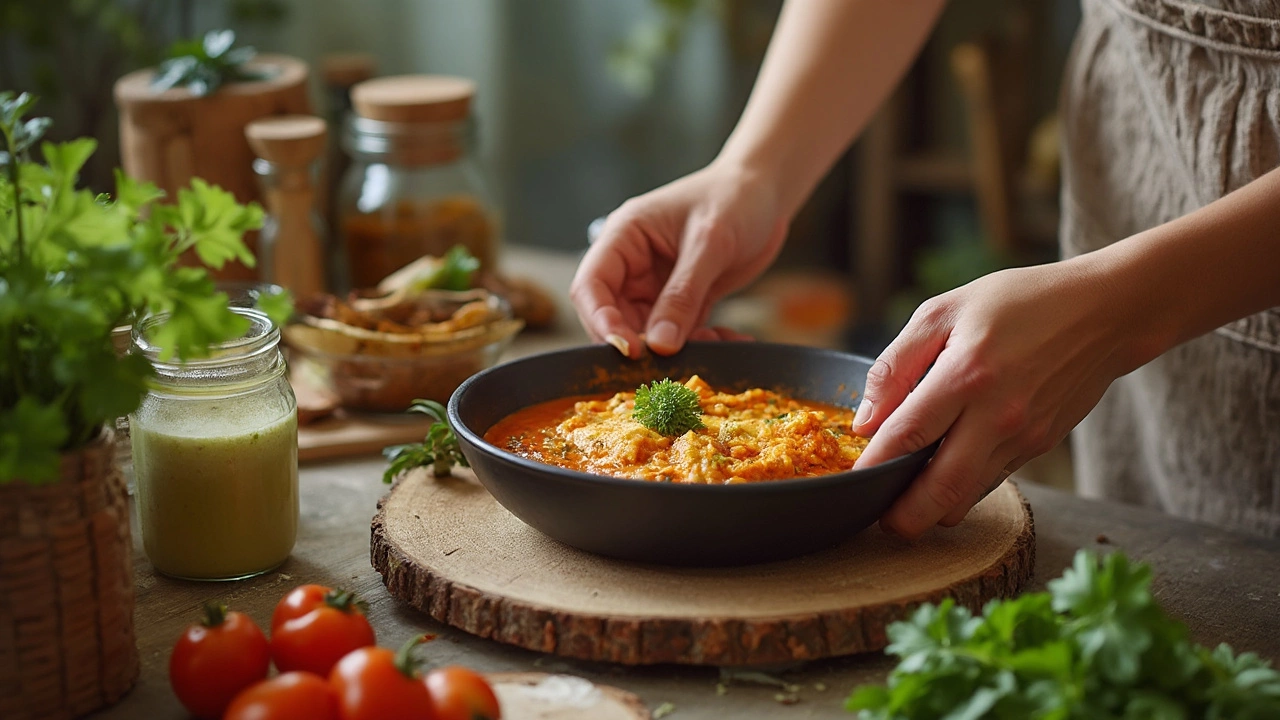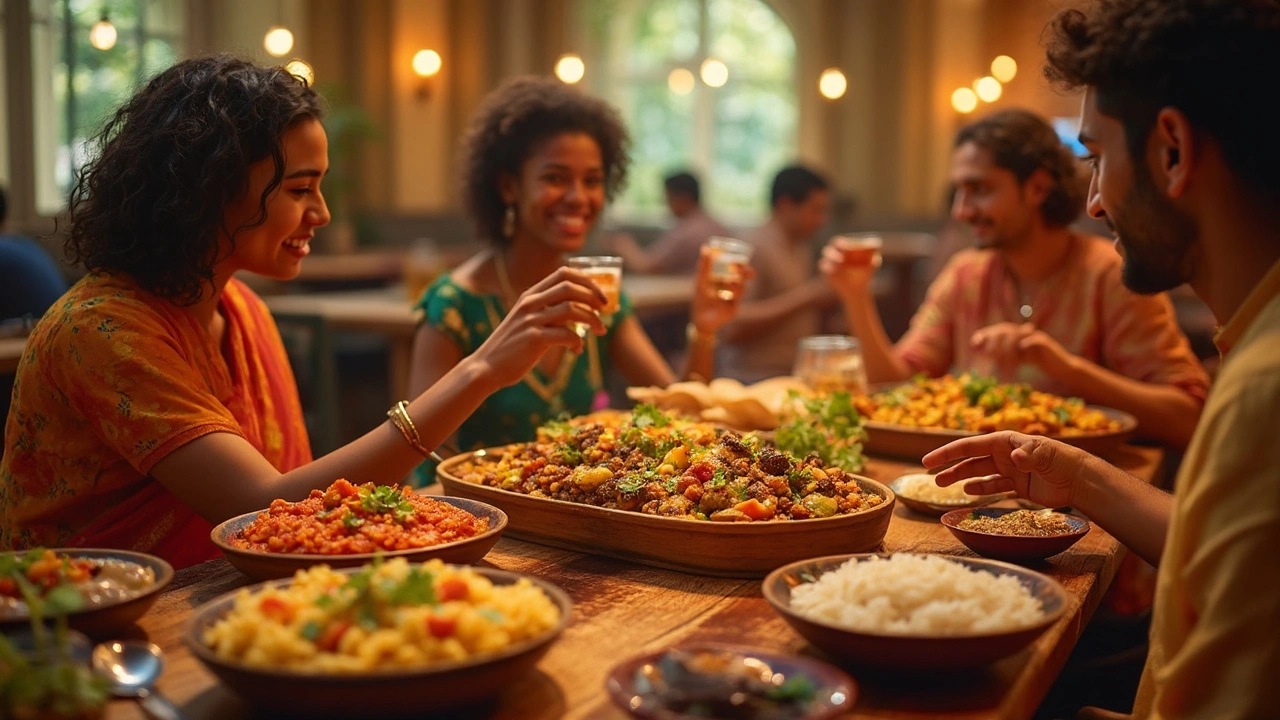If you think all Indian curries are loaded with cream or butter, think again. Plenty of delicious vegetarian curries use no dairy at all—they just don’t advertise it. Knowing which ones fit a dairy-free diet can save you so much hassle, especially if you’re eating out or trying new recipes at home.
Why does this matter? Even a little bit of hidden ghee or yogurt can throw off your food plans if you’re avoiding dairy for health or personal reasons. Let’s get you sorted with some common, real-world vegetarian curries that are naturally dairy free—and how to spot sneaky dairy in others.
You might be surprised by how much variety you’ll find, too. Forget missing out: the spices, lentils, veggies, and bold flavors in these curries are all you need. Ready for a game plan that’s safe, tasty, and seriously satisfying?
- What Makes a Curry Dairy Free?
- Classic Vegetarian Indian Curries Without Dairy
- Watch for Hidden Dairy: Restaurant and Store Tips
- Easy Swaps to Make Recipes Dairy Safe
What Makes a Curry Dairy Free?
So, what’s the actual deal with a dairy free Indian curry? It’s simple: no cow’s milk, cream, yogurt, paneer, ghee, or butter. If the dish skips all these, it counts as dairy free, even if it's creamy from something else—like coconut or blended lentils.
Indian curries don’t all follow the same rules; some regions use a lot of dairy, while others rely on spices, veggies, or coconut for flavor. For example, North Indian curries often include butter or cream to get that rich texture—think paneer makhani or malai kofta—while South Indian curries usually use coconut milk or oil instead.
- Common dairy ingredients to watch for:
- Paneer (fresh cheese)
- Yogurt (curd or dahi)
- Cream (malai)
- Ghee (clarified butter)
- Plain butter
- Safe non-dairy bases:
- Coconut milk or cream
- Tomato gravy
- Lentil puree (dal)
- Vegetable stock
- Plant oils (sunflower, mustard, coconut, etc.)
You don’t need to memorize every Indian spice to get dairy free food. Just look out for those common ingredients listed above. By the way, here’s a comparison of dairy versus dairy free curry bases that comes up a lot:
| Curry Type | Common Base | Usually Dairy Free? |
|---|---|---|
| Chana Masala | Tomato, chickpea, spices | Yes |
| Dal Tadka | Lentils, oil, spices | Yes |
| Saag Paneer | Spinach, paneer, cream | No |
| Vegetable Korma | Cream, nuts, spices | No (unless coconut based) |
| Vegetable Curry (South Indian) | Coconut milk, veggies, spices | Yes |
A little attention to these details can spare you a lot of accidental dairy drama. If a curry is creamy but comes from tomato or coconut, you’re good to go. If you spot words like “makhani,” “malai,” or “paneer,” it probably isn’t safe unless you know for sure it’s made with substitutions. When in doubt, always ask the cook or server.
Classic Vegetarian Indian Curries Without Dairy
Here’s the good news: you’ve got loads of vegetarian dairy free Indian curries to pick from. Lots of Indian homes whip up these dishes every week, and there’s no need for heavy cream or butter to get real, bold flavor. If you know where to look, you can order safely at any decent Indian place or make them in your own kitchen.
Some of the best-loved curries don’t rely on any dairy at all. Instead, they use spices, tomatoes, and coconut milk (sometimes) for that rich texture. You might recognize a few of these already:
- Chana Masala – Chickpeas cooked in a tangy tomato-onion gravy, packed with ginger, cumin, and garam masala. No cream, no yogurt, just pure spice.
- Rajma – Kidney beans slow-cooked with tomatoes, onions, and a boatload of North Indian spices. Super hearty and usually oil-based.
- Baingan Bharta – Smoked eggplant mashed with tomatoes, onions, and fresh coriander. Done right, not a drop of milk or ghee involved.
- Bhindi Masala – Okra sautéed with onions, tomatoes, spices, and finished with lemon juice. Totally plant-based.
- Mix Vegetable Curry – Carrots, beans, peas, and potatoes in a tomato-onion base. Cream gets added only if you ask for it.
Take a look at this table for a quick dairy-free cheat sheet—so you can see what’s almost always safe to order or cook:
| Curry Name | Main Ingredients | Common Dairy Additions |
|---|---|---|
| Chana Masala | Chickpeas, Tomato, Onion | Rare (never in classic recipe) |
| Rajma | Kidney Beans, Tomato, Onion | Possible butter if restaurant-style |
| Baingan Bharta | Eggplant, Tomato, Onion | Ghee (sometimes), but easy to skip |
| Bhindi Masala | Okra, Onion, Tomato | Rarely any dairy |
| Mix Vegetable Curry | Seasonal Veggies, Tomato, Onion | Cream (optional, not standard) |
Quick tip: in southern Indian curries like Sambar (lentil and vegetable stew), coconut is king—no dairy required. These dishes go big on tamarind, lentils, and coconut, so you’re set if you see them on a menu.
You’ll notice that the only time these curries might not be dairy free is if the cook adds butter (“makhan”) or tops things with cream for extra richness. Just ask for yours without it, and you’re safe. When you’re eating anywhere in India, home-cooked versions stay true to the dairy-free roots most of the time. Packaged or restaurant versions might cut corners, so a quick heads-up never hurts.

Watch for Hidden Dairy: Restaurant and Store Tips
Let’s be real: figuring out what’s actually dairy free at Indian restaurants isn’t always simple. Dishes that look vegan might sneak in ghee (clarified butter), cream, paneer, or yogurt. Even that spicy dal might have a pat of butter melting on top. You don’t want to guess—so here’s how to make sure you get a real dairy free Indian curry instead of a surprise.
- Always ask about ghee. Restaurant staff will rarely mark it on the menu, but it pops up in cooking and drizzled on finished food. Politely ask: "Is this made with ghee or butter? Can you make it with oil instead?"
- Check the base. Some classic curries like chana masala and rajma are often cooked in oil, not butter, but others (think paneer dishes or malai-based gravies) are definitely out.
- Look for yogurt and cream. Dishes like dal makhani, some biryanis, and kormas might have hidden dairy blended into sauces, not just as a topping. A quick question helps a lot.
- Read product labels at the store. Indian “ready to eat” curries sound healthy, but even those labeled vegetarian can have milk solids, cream, or casein. Look for allergy info on the packaging—if it says "Contains: Milk" or lists butter/ghee, put it back.
According to the Indian Food Safety and Standards Authority (FSSAI), nearly 40% of pre-packaged curries in Indian grocery shelves contain some form of dairy—so the odds aren’t always in your favor if you just pick randomly.
"Ghee, butter, cream, milk powder, and yogurt are frequently used in North Indian curries—even when the dish looks like it could be vegan," says Chef Preeti Mistry, cookbook author and restaurant consultant.
So you know what to watch for, here’s a little cheat sheet of the names and words that often signal hidden dairy in restaurant dishes or packaged curries:
| Common Ingredient Name | Hidden Dairy Risk? |
|---|---|
| Ghee | Yes (Clarified Butter) |
| Paneer | Yes (Indian Cheese) |
| Malai | Yes (Cream) |
| Dahi | Yes (Yogurt) |
| Butter | Yes |
Bottom line? Don’t feel weird about asking, double-checking labels, or being specific with your order like “no ghee, cream, yogurt, paneer, or butter.” Staff at Indian places are familiar with requests—so let them help you stay dairy free!
Easy Swaps to Make Recipes Dairy Safe
If you want to cook dairy free Indian curry at home, you don’t have to give up on taste or a creamy texture. Most recipes calling for milk, cream, ghee, or yogurt can be switched up with a few smart substitutes you probably already have. The goal: keep things tasty, use easy-to-find stuff, and avoid dairy without a headache.
Here are some practical swaps that work well in Indian curries:
- Coconut Milk or Cream — For a naturally rich sauce, coconut milk or even coconut cream gives you that thick, creamy goodness. It's perfect for curries like korma or tikka masala. Stick to unsweetened versions for savory recipes.
- Plant-Based Yogurt — Need that classic tang? Go for soy yogurt or almond yogurt. Both mimic the sour touch of dairy yogurt and blend right in. Look for plain, unsweetened versions.
- Cashew Cream — Soak cashews, blend them up, and you’ve got a smooth, neutral base that really shines in creamy curries. It’s a favorite in vegan Indian recipes for good reason.
- Oil Instead of Ghee — Switch out ghee for neutral oils like sunflower, canola, or even olive oil. Ghee gives a nutty flavor, so for extra aroma, try mustard or coconut oil.
Watch out for certain recipes that sneak in paneer (that's cheese!), fresh cream, or even small splashes of milk. A simple swap at that step keeps the dish dairy safe. Here's a quick reference table for the most common swaps:
| Dairy Ingredient | Easy Dairy-Free Swap |
|---|---|
| Milk | Coconut milk, almond milk, or soy milk |
| Cream | Coconut cream, blended cashews |
| Yogurt | Unsweetened plant-based yogurt |
| Paneer | Firm tofu, soy paneer, or extra vegetables |
| Ghee | Neutral oils or coconut oil |
Some store-bought vegan yogurts can be watery, so if you like a thicker sauce, try straining the yogurt in a sieve for an hour before mixing it in.
Don’t forget—Indians regularly sub ingredients based on what’s available or who’s eating, so home cooks do these swaps all the time. There’s nothing odd about it. If you’re new to these options, try a half-batch first to adjust flavors. You’ll see how easy it is to whip up a dairy-free curry that fits your taste and diet.
